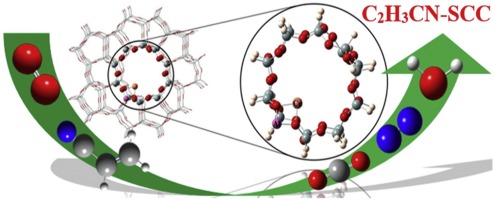Catalysis Today ( IF 5.2 ) Pub Date : 2018-04-25 , DOI: 10.1016/j.cattod.2018.04.054 Ning Liu , Dongjun Shi , Runduo Zhang , Yingxia Li , Biaohua Chen

|
A series of Cu (5 wt%) modified microporous zeolites (ZSM-5, Beta, MCM-22, MCM-49, and Y) was investigated for selective catalytic combustion of acrylonitrile (C2H3CN-SCC), associated with N2 yield order of Cu-ZSM-5 (SiO2/Al2O3 = 26) > Cu-MCM-49 > Cu-MCM-22 > Cu-Beta > Cu-Y. Various characterizations of XRD, N2 adsorption, H2-TPR, NH3-TPD and XPS were employed to reveal structure-activity relationship. It was suggested that (i) isolated Cu cation acting as active center played a major role in C2H3CN-SCC; (ii) lowering SiO2/Al2O3 ratio could enhance ion-exchanging capacity and thereby improve the zeolitic catalytic behavior; (iii) Cu-ZSM-5 (SiO2/Al2O3 = 26) possessed the largest amounts of Cu cations as well as the highest Cu2+ → Cu+ redox ability, being responsible for its excellent catalytic behavior. C2H3CN-SCC mechanism over Cu-ZSM-5 was further investigated by in situ diffuse reflectance infrared Fourier transform spectroscopy (in-situ DRIFTS) and density functional theory (DFT) calculation. C2H3CN-SCC mainly followed an oxidation mechanism via intermediate of NCO in absence of H2O; however, after an introduction of H2O hydrolysis mechanism was dominated involving NH3 intermediate. DFT simulation majorly focusing on NCO formation mechanism reveals that C2H3CN could be initially adsorbed on active center Cu of Cu-ZSM-5 through its N, associate with atomic C of CN being adsorbed with a dissociated atomic O. Such kind of adsorption mode greatly favored C2H3CN bond fracture to produce NCO, of which the energy barrier was calculated to be 17.0 kcal mol−1. Mulliken charge transfer (CT) analysis was further conducted, based on which the electronic properties of active center Cu, zeolite framework and dissociated atomic O were well illustrated.
中文翻译:

铜改性沸石对丙烯腈向氮的高选择性催化燃烧
研究了一系列的Cu(5 wt%)改性微孔沸石(ZSM-5,Beta,MCM-22,MCM-49和Y)用于丙烯腈(C 2 H 3 CN-SCC)的选择性催化燃烧,以及Cu-ZSM-5(SiO 2 / Al 2 O 3 = 26)的N 2屈服次序> Cu-MCM-49> Cu-MCM-22>Cu-β> Cu-Y。利用XRD,N 2吸附,H 2 -TPR,NH 3 -TPD和XPS的各种表征方法揭示了结构-活性关系。建议:(i)分离出的铜阳离子作为活性中心在C 2 H 3 CN-SCC中起主要作用;(ii)降低SiO 2 / Al2 O 3的比例可以提高离子交换能力,从而改善沸石的催化性能。(iii)Cu-ZSM-5(SiO 2 / Al 2 O 3 = 26)具有最大量的Cu阳离子以及最高的Cu 2 + →Cu +氧化还原能力,这归因于其优异的催化性能。通过原位漫反射红外傅里叶变换光谱(原位DRIFTS)和密度泛函理论(DFT)计算,进一步研究了Cu-ZSM-5上C 2 H 3 CN-SCC的机理。C 2 H 3 CN-SCC主要在不存在H的情况下通过NCO中间体遵循氧化机理2 O; 但是,引入H 2 O后,水解机理占主导地位,其中涉及NH 3中间体。DFT模拟主要关注NCO的形成机理,结果表明C 2 H 3 CN最初可以通过其N吸附在Cu-ZSM-5的活性中心Cu上,而CN的原子C则被离解的原子O吸附。吸附模式极大地促进了C 2 H 3 CN键断裂而生成NCO,据计算其能垒为17.0 kcal mol -1。进一步进行了Mulliken电荷转移(CT)分析,在此基础上很好地说明了活性中心Cu,沸石骨架和离解的原子O的电子性质。


















































 京公网安备 11010802027423号
京公网安备 11010802027423号